Tips on Having a Survival Knife
Importance
A knife is the most important tool to have when you’re outdoors or in a survival situation. Its use is unparalleled because you can make fire, shelter, container and cordage from having a knife alone, and it can even help you with wood chopping and in doing first aid. It is important that one is equipped with the knowledge of what knife to buy or carry because not all knives are the same.
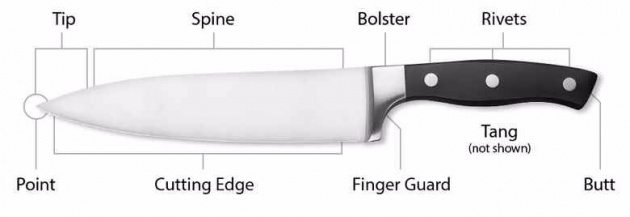 photo credit to kohls.com
photo credit to kohls.com
The Ideal Survival Knife
The ideal survival knife is one that can be used for different tasks without having to worry of it breaking or getting dull easily. Survivalists agree that the ideal knife should:
- Be in full tang
- Be a fixed blade
- Have a straight edge
- Have drop-point tip
- Have a thick and flat ground spine
- Be made of carbon steel
- Be in the right size for your hand
- Have a comfortable grip
Tang
What is a tang in a knife? It is how the metal part of the knife is made from the tip extending to the handle. If you still don’t get it, here is a picture of the types of tangs in a knife:
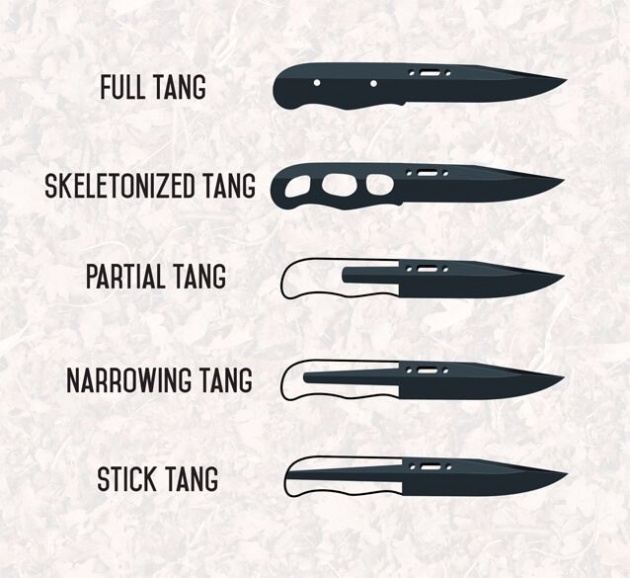 photo credit to blog.topspecus.com
photo credit to blog.topspecus.com
Survivalists say that a full tang knife is ideal because it is the strongest-built blade out there. The pressure is distributed from the blade tip to the butt of the knife. Your grip is secured and you won’t have to worry about the blade slightly bending backwards or forwards or the blade breaking off in the middle. It is also not prone to breaking and getting loose with the handle when regularly used. A full tang knife would also assure you that when the handle gets destroyed, you can build another one by simply following the pattern of the handle side of the metal.
Fixed Blade
A knife with a fixed blade is the one that doesn’t fold up to reveal the blade, like in a Swiss army knife. The metal is built in one continuous shaft without any connecting screws, unlike a folding knife. Like in a full tang, you won’t have problems getting the blade to unintentionally and dangerously fold backwards or forwards so as to cut you. A fixed blade is also dependable as is it strongly built than a folding knife.
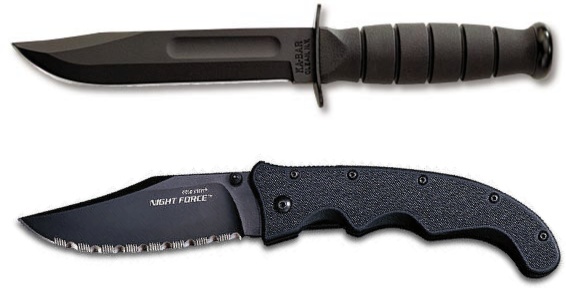
photo credit to knife-depot.com
Straight Edge
A straight edge knife is an ideal knife than a serrated edge knife because it is easier to sharpen and is more useful than its counterpart. You can use it for prying, dressing game, making tinder, in first aid, and most importantly for cutting things efficiently.
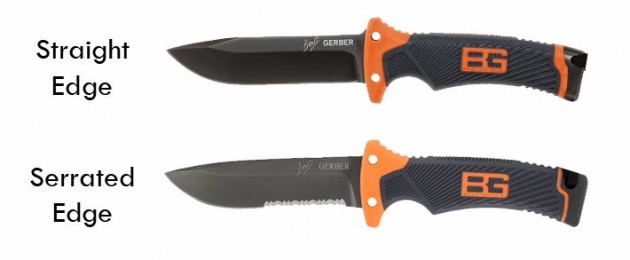 photo credit to survival-knives.co.uk
photo credit to survival-knives.co.uk
Drop-point Tip
It is ideal because you can use it for stabbing and dressing game, for defense against wild animals, for boring holes especially in repairing clothes, for removing splinters, and many others. A drop point tip is advantageous because it has a sturdy architecture behind it and it won’t break as easily as in a clip point blade.
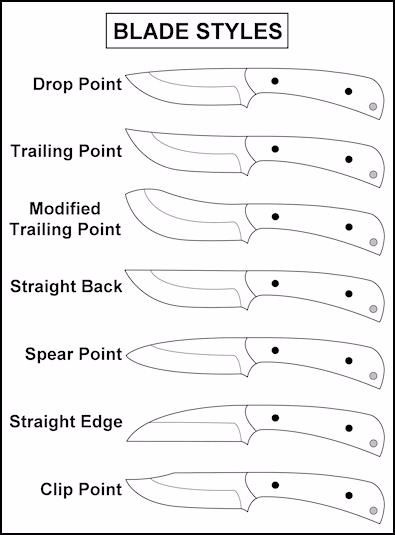 photo credit to preparedgunowners.com
photo credit to preparedgunowners.com
Thick and Flat Spine
Having a thick and flat ground spine (as shown in the first picture, the spine is the back side of the knife’s cutting edge) is a highly coveted characteristic of a survival knife. A thick and flat ground spine means it would be easier to do batoning. It is the method wherein you hammer down a big chunk of wood onto the knife's spine so that the knife buries down deeper into another wood you wish to split in half. The method should look like this:

photo credit to morethanjustsurviving.com
Besides batoning, having a thick spine is advantageous because it will not hurt when you put pressure on the knife’s spine with your palm.
Carbon Steel
High carbon steel is the preferred choice of bushcrafters over stainless steel because it is more durable and cheaper than the latter. It is harder than stainless and the latter is softer and lighter in composition which tends to lose its edge faster than high carbon steel.
Size
This criteria for having a survival knife is subjective, but the ideal size should fit your hand nicely without putting a hindrance to your everyday tasks. Most people gauge that a knife should measure around 7 to 11 inches, but a handful also prefer larger ones. What’s important is that you are comfortable gripping it and carrying it around. It is also essential that it won’t put too much stress on your wrist whenever you use it.
Grip
This is also a subjective characteristic of what an ideal knife should have/be. Many prefer a wooden grip, others a durable plastic handle. Some just also settle for a grip made by wrapping a sturdy cord around the handle side of the knife. The point is that the grip should be comfy for you to hold and it should cause you to have wounds.
The Preferred Survival Knife
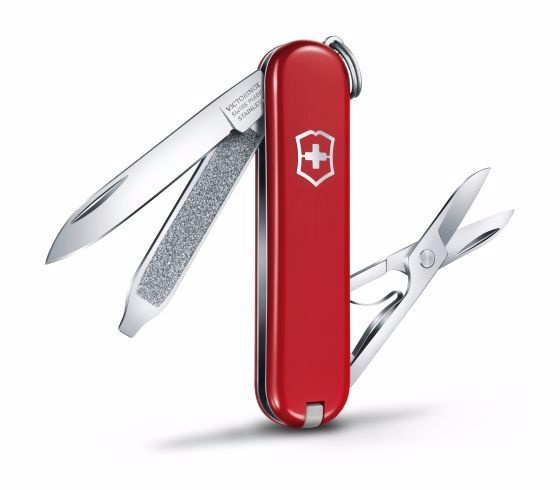 photo credit to victorinox.com
photo credit to victorinox.com
Although there are tons of bushcrafters who put much effort in guiding would-be knife owners about what to look for in a knife, their advice are often disregarded. It is because the ideal knife has disadvantages. Its characteristics are not always suited for someone’s everyday tasks and preferences.
A survival situation means it is an uncalled for scenario, so a knife in this matter would only be an asset for contingency plans and nothing more. Sure, a 7-inch full tang, fixed-blade knife would be extremely helpful in this event, but you will attract unwanted attention from the public eye and authorities if they see you lugging around a knife of this caliber every day.
Most people who opt to conceal their everyday carry knife have a folding knife. A folding knife also means it doesn’t have a full tang and is prone to bending awkwardly, especially if it isn’t cleaned regularly. Still, it is regarded as indispensable and can function as its full tang, fixed blade counterpart. On a personal note, I prefer a folder over a fixed blade because I can conceal it and it doesn’t take as much space in my pocket. But I feel a slight discomfort in a Swiss army knife because it doesn’t have a finger guard. I feel that a finger guard is important because it protects your fingers from pushing through the knife’s edge, especially when you use the knife for stabbing or thrusting. Without it I might have scars on the palm of the fingers.
Another problem in having an ideal knife for everyday carry: it can create problems especially when entering premises that don’t allow things with blades. You can get through with this dilemma by simply purchasing a stealthy knife like a key knife, or a dog tag knife. They are the next best thing when boarding airplanes or ships, although you should only bring one if you think it is the best option because you should follow flight or cruise rules.
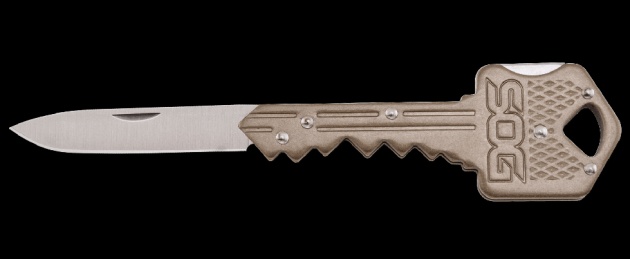
photo credit to sogknives.com
Many a group of survivalists choose stainless over carbon because it doesn’t rust easily compared to carbon steel knives. It is also more readily available and although it gets easily blunt, it is more flexible than the harder and more brittle carbon steel so it’s less prone to breakage.
Maintaining the Knife
In order to take care of your knife and make it usable, you should regularly sharpen it. Although it is not necessary to carry a knife sharpener around, it is best to be knowledgeable how to sharpen a knife with the provided resources available. Below is a video with 5 methods to sharpen a knife.
video credit to CrazyRussianHacker from youtube.comDo remember that you should tilt the knife to 15-30 degrees against the sharpening tool to create an edge instead of scraping the sides. Also, you can use your ceramic coffee cups, lids of glass, metal files, your leather belt (tied around a post or tree), or even in pavement. Sharpening iron against iron needs a bit of a know-how because you must sharpen your knife on another harder steel knife; you will know which is harder by their name of the steel used.
If you still want a reliable knife sharpener to carry around without being bulky, you can buy a card sharpener like this: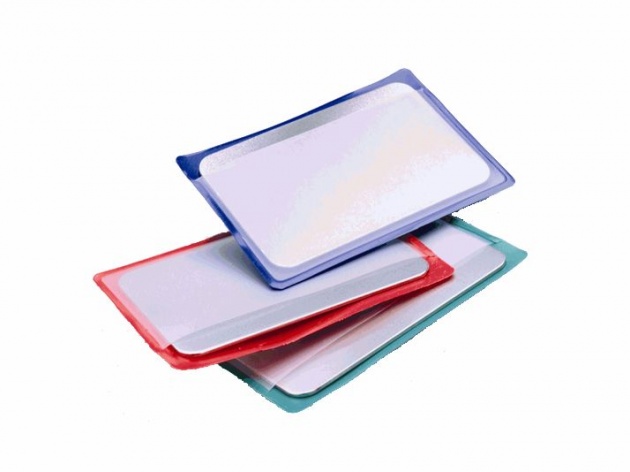
photo credit to dmtsharp.com
Another thing is that you should keep your knife dry and clean after every use. Blood stains might hasten the rusting process of your knife and you should keep it clean because a survival knife is an all-around tool which means you also use it to prepare food. Also, you should oil your knife especially the ones with folding blades so it will lock and snap smoothly and you won’t have to worry about folding it into place. With fixed blades, you should oil it regularly so that it won’t get stuck on its sheath.
Having a survival knife lets you feel secure of what’s to come. There are tons of survival knives in all shapes and sizes but the best one for you should do the tasks you want it to fulfill without hurting your wallet nor your hands. Best wishes in getting one!
Disclaimer: P/V not mine. Writeup 0% plagiarized.



